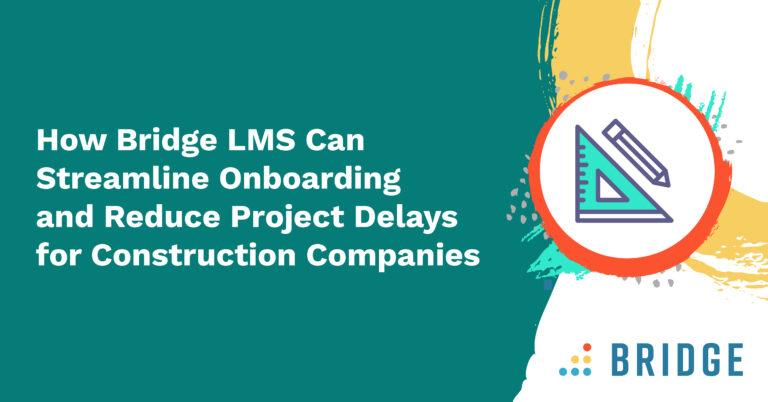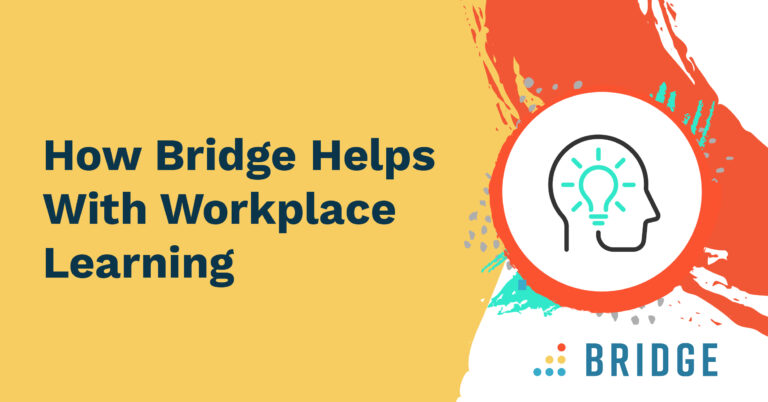The challenges that businesses face are constantly evolving, and the software you select must help you effectively address the key organizational concerns of the day. In this article, Bridge Solutions Engineer Shaun Wilson talks us through five trends we—alongside the learning software industry at large—have noticed having a profound impact on learning management software purchasing habits in recent years.
1) The Software You Select Must Cater to Increasingly Diverse Departmental Drivers
Depending on who’s driving the purchase of a new employee development platform, we tend to see a range of different factors informing the conversation.
- L&D teams may be mostly concerned with uniformly delivering compliance training to their organization and are likely to focus on features that make this easier. For example, they may require authoring tools that deliver responsive course formats that work on any device and are likely to need ways of easily tracking activity.
- Technical/IT teams are often looking for a piece of software that integrates with their existing tech stack and can flex to future organizational growth (whether planned or unplanned). They’ll often be tasked with growing their system capabilities without hiring more admins—so new software must be flexible and unobstructive.
- HR teams will likely be focused on the performance management aspect and will need systems that help them create objective measurements and provide granular analytics for talent-management decisions.
If you’re among any of these groups and considering a software purchase, you’ll know your own motivations, but have you considered the shared impact or benefits of your choice across the broader organization? The needs of other departments aren’t irrelevant to your purchasing decisions.
A proposal to buy a platform that serves multiple organizational needs is more likely to gain approval—and sometimes shared budgetary resources. Having other stakeholders on your side will ensure your own plans aren’t met with resistance by areas of the business with legitimate reasons to avoid change. Therefore, the earlier you get other departments in on the conversation, the better.
2) Your Competitors May Be Focused on Progressing Their Development Culture—Even If You’re Not!
In addition to the aforementioned departmental drivers, corporate culture strongly influences the kinds of software an organization buys. Some (typically larger) organizations may have mature, hardened development processes in place. They’ll have a clearly defined idea of their needs and may seek a product that can be tweaked to fit their processes. But they may also be more rigid in what they offer their employees, which can make them less competitive in the labor market in certain aspects.
Organizations with more progressive development cultures may be motivated to seek software that enhances their connection to their people, driving employee development and growth as contributors and professionals. In the Bridge-sponsored “Future of Upskilling and Employee Learning 2024” report, we found that organizations that identified as “leaders” in L&D were two times more likely to identify upskilling as their top priority (47% vs 28% of organizations identified as “laggards”).
Such organizations will have more flexibility around process and prefer software that is perhaps more templated, with less control over the smallest details. They will also offer a greater emphasis on user simplicity and an all-encompassing best-practice approach that remains relevant regardless of how the organization and its processes evolve.
ENGAGE EMPLOYEES WITH THESE INSIGHTS | ‘2024 Employee Engagement Trends You Need to Know’
3) Scalability Is a Key Concern Regardless of Organization Size
G2’s 2023 Software Buyer Behavior Report surveyed over 1,700 buyers and asked them to choose from a list of 14 considerations currently motivating their purchasing behavior. “Ability to scale as my team/company grows” was a top five concern for businesses of all sizes. For medium-sized companies and enterprises, it was a top three concern. How easy the tool is to implement was also seen as a first or second priority across all groups.
The impression is that, to a certain extent, the winning tools are those that buyers will “get in and get out of the way”: they’ll work with the organization you have now without much fuss and flex to the demands of the organization you’ll have tomorrow without becoming an issue.
Even within any given business, many different stakeholders will have a preference for a scalable tool. Someone in a technical function will seek software that allows them to ramp up and stay interactive as their user base grows. They may be more focused on how this potential to scale is achieved while maintaining information security and staying within data privacy regulations.
L&D professionals, on the other hand, are often acutely aware that an increase in headcount in the business is rarely matched with a corresponding increase in their own team size. Whether they have to deliver training to 500 or 5,000 people, they need to be confident they can do so without anyone falling through the cracks, accounting for the compliance of employees entering, leaving, returning, or having a remedial training requirement. Scaling may not just be a matter of headcount—the software may need to help teams scale across language requirements and device habits too.
The software’s own scalability is only part of the picture: another important dimension is what the tools can reveal to an organization about itself. For example, a construction company may bid for a contract that could double or even triple the size of its business overnight. In that situation, it needs to know what skills it already has access to and identify the gaps it will have to hire and train in order to fill.
4) AI Is Changing the Game—But Buyers Must Be Cautious
No current trends piece is complete without a mention of AI, and with good reason. Returning to G2’s report:
- 81% of respondents said that moving forward, it was important or very important that the software they purchased has AI functionality.
- 78% said they trust the accuracy and reliability of AI-powered solutions.
- 59% of AI buyers anticipate spending in 2024 will increase.
Software buyers demand AI functionality, so the market is providing it. Bridge Learn & Develop, for example, offers AI-driven skills taxonomies, skills auto-tagging, and skills-based learning recommendation functionalities, helping you understand your existing talent inventory and close skills gaps. These features play to the core strengths of these new AI capabilities: the ability to quickly and accurately draw useful information out of large datasets.
Of course, this universal demand for AI comes with some potential pitfalls. For starters, it may lead organizations to feel that they need to make purchases that include AI simply for AI’s sake, regardless of the actual practical application of the technology. Equally, this can lead to unscrupulous vendors integrating any old form of AI they can into their products just to have another bullet point on their feature list.
An even larger concern is that AI’s capabilities may make the process of software purchasing more complex. A worrying 55% of respondents to the G2 survey said that they circumvented their IT vetting processes when making software purchases—a key group we’ve already advocated to be part of the conversation.
IT is usually in charge of checking the information security credentials of any software and ensuring that the organization remains within data privacy laws. However, solutions using generative AI may actually require the direct involvement of an organization’s legal department due to the breadth and complexity of the data processing involved.
This presents a dual challenge to your ability to onboard your intended software. Firstly, legal counsel is less likely to have the technical expertise to understand the AI’s capabilities. Secondly, even though they’re expert lawyers, the law itself is still being shaped. They have a job to protect your business’ intellectual property and your clients’ data, and if they feel uncomfortable, they may feel it’s much safer to simply say “no”.
This is yet another area where the right vendor can make all the difference in the world—one that’s prepared to help your legal counsel understand what their software does and the implications for your data.
5) Teams Want Analytics That Provide the Right Kinds of Proof
In the last few years, we’ve seen a general trend toward teams being asked to do more with less. L&D teams, particularly, may be at risk of cuts when budgets start to fall. Software is depended on to fill the void one way or another, either by making it easier for small teams to do more without extra personnel or by helping teams provide evidence of the real value they’re bringing to the business.
This means that different parts of your business will continue to lean on the software’s analytics and reporting capabilities, so these features must be robust. L&D will often need to track compliance, but departments in high-consequence industries such as healthcare may need to be able to track and ensure compliance much earlier in their processes.
Meanwhile, HR teams may need to track the following:
- Managers having regular check-ins with their reports
- Employee alignment with corporate goals
- Metrics necessary for performance review calibration, proving that decisions are unbiased
- Quantitative and qualitative metrics related to succession planning
And this list is far from exhaustive. Tracking may involve a number of eLearning data standards, such as SCORM and xAPI, and for some organizations, there may need to be a way of tracking activity outside of the system—such as certifications earned or attendance at in-person events.
It’s also not enough for the platform to track these metrics. Individual departments often need to be able to communicate their outcomes to leadership or stakeholders in other parts of the business and, as a result, it’s important that the reports they have access to are easy to interpret.
USEFUL INSIGHTS FROM THE BLOG | ‘How to Create an L&D Budget You Can Defend to Your CFO’
Meaningfully Address These Trends and More With Bridge
Meet your organizational challenges head-on with Bridge, the learning and development platform that’s so much more than an LMS. Improve every facet of your people processes, from onboarding and compliance training to skills gap analysis and performance conversations in one easy-to-use environment.
With our support, you can ensure HR, IT, and L&D receive the right blend of features to fulfil their diverse goals within sometimes restrictive budgets, while keeping your people happy, engaged, and open to new possibilities in your organization.



